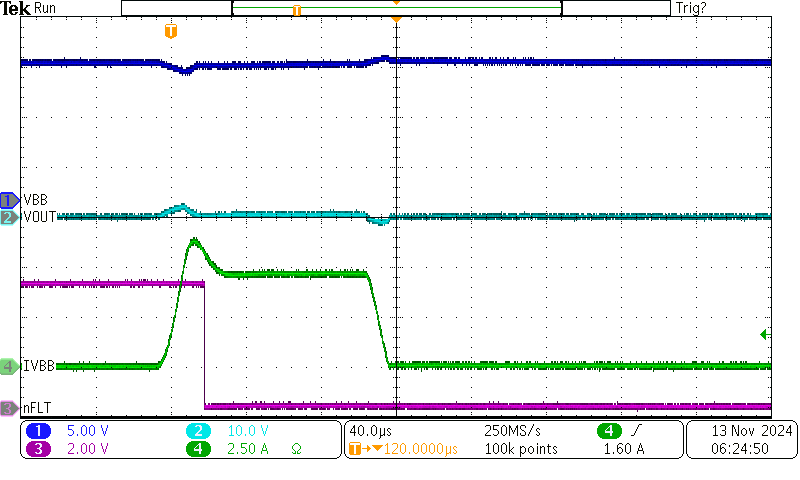SLVSH18 December 2024 TPS4HC120-Q1
PRODUCTION DATA
- 1
- 1 Features
- 2 Applications
- 3 Description
- 4 Pin Configuration and Functions
- 5 Specifications
-
6 Detailed Description
- 6.1 Overview
- 6.2 Functional Block Diagram
- 6.3 Feature Description
- 6.4 Device Functional Modes
- 7 Application and Implementation
- 8 Device and Documentation Support
- 9 Revision History
- 10Mechanical, Packaging, and Orderable Information
5.8 Typical Characteristics

| VBB = 13.5V |

| ENx = 0V | DIAG_EN = 0V |

| IOUT = 0.5A |

| EN1, 2 = 5V | EN3, 4 = 0V | DIAG_EN = 0V |

| DIAG_EN = 5V | EN1 = 5V | EN2, 3, 4 = 0V |
| No load condition |
 Figure 5-11 SRF
vs Temperature Over VBB Voltage
Figure 5-11 SRF
vs Temperature Over VBB Voltage Figure 5-13 SRR
vs Temperature Over VBB Voltage
Figure 5-13 SRR
vs Temperature Over VBB Voltage
| VBB = 13.5V | RSNS = 1kΩ | ILIM = OPEN |
| ROUT = 10Ω | TAMB = 25°C |

| VBB = 13.5V | RSNS = 1kΩ | ILIM = OPEN |
| ZOUT = 100mΩ + 5μH | TAMB = 25°C |

| TAMB = 25°C |

| VBB = 13.5V |

| EN1 = 5V | EN2, 3, 4 = 0V | DIAG_EN = 0V |

| EN1, 2, 3, 4 = 5V | DIAG_EN = 0V |
 Figure 5-10 tDF
vs Temperature Over VBB Voltage
Figure 5-10 tDF
vs Temperature Over VBB Voltage Figure 5-12 tDR
vs Temperature Over VBB Voltage
Figure 5-12 tDR
vs Temperature Over VBB Voltage
| VBB = 13.5V | RSNS = 1kΩ | ILIM = OPEN |
| ROUT = 10Ω | TAMB = 25°C |

| VBB = 13.5V | RSNS = 1kΩ | ILIM = OPEN |
| ROUT = 10Ω | TAMB = 25°C |

| VBB = 13.5V | RSNS = 1kΩ | ILIM = Short-to-GND |
| ZOUT = 100mΩ + 5μH | TAMB = 25°C |